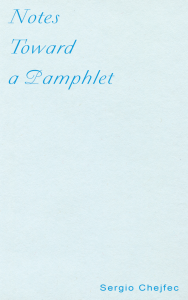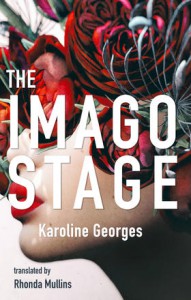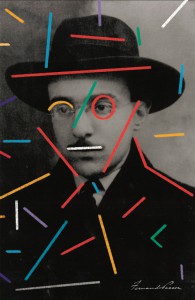This month, our selections of the best in newly translated global literature consists of a thrillingly varied medley of styles, from a fictional Argentine study on an obscure poet, a French-Canadian narrative of images and their thrall, and Fernando Pessoa’s cheekily fabricated dossier of a fascinating character. Though they may perhaps be united by a mutual captivation for how the mundane strikes the artistic process, the writers of these exciting works are transforming what may be familiar matters with a unique and singular language. Read on to find out more!

Notes Toward a Pamphlet by Sergio Chejfec, translated from the Spanish by Whitney DeVos, Ugly Duckling Presse, 2020
Review by José García Escobar, Editor-at-Large
As much as Sergio Chejfec’s Notes Toward a Pamphlet offers a detailed voyeuristic look on trains, passengers, silence, and a radio announcer eating carrots, it’s also a gripping character study filled with philosophy and subtle humor. The use of randomness and meticulous narration of everyday, seemingly ordinary events, are no rarity in Chejfec’s work—the internal monologue of Masha, the meditative hotel clerk in his novel The Incompletes, as one example. Though they may appear disjointed, they often ignite the narrative and strengthen the enigma.
I think of Onetti and Piglia, and Chejfec, with his hidden tension and disarmingly beautiful writing—amplified by Whitney DeVos’ fiery translation—holds his ground against such giants.
In Notes Toward a Pamphlet, we see a nameless narrator following, or rather, discovering a poet named Samich. Unknown and unpublished, Samich does not even have a completed book to his name. He is solitary and lives a sedentary life in rural Argentina. His work, we learn, is scattered in magazines and “collectively-authored books.” But we can’t talk about poems per se. For these publications, Samich takes a fragment, at random, from the “writing mass.” There are no themes in his writing. No topics, concerns, or inspiration. No coherence or unity. But this is not an eccentricity. This, we understand, as we get to know Samich, is the way he viewed and experienced literature, based on “intuition instead of ideas.” Samich’s literary ways and lifestyle are almost like the antithesis of Bolaño’s Visceral Realists.
Notes Toward a Pamphlet is not bound by plot. There is no plot, but there is movement. But movement, motion, progression, and development, though noticeable, is rarely explicit. There’s barely any dialogue, action, interaction between characters, or issues to be resolved. Instead, we watch Samich grow. We see his flaws and contradictions. But his evolution occurs not in an artificial, literary way, but closer to how people experience it in real life: subtly and slowly. Samich’s growth is almost imperceptible. And while his life seems unexceptional and tedious, Chejfec’s mesmerizing writing, and the narrator’s prying, maintains the momentum.
The author turns silence into oddity, calm into mystery, and tedium into suspense and wonder. In Note 11.4.3. Sergio writes:
One night, he has another dream. Samich turned into a bee, allowing him to visit authors of the past as if they were flowers, to gather nectar from their talent. Everything is fine until, in the dream, he discovers the authors are represented by ancient corpses, not by their books. The bee shakes its head without knowing what it really is—a bee does not visit corpses. At that point, Samich wakes up in a state halfway between frantic excitement and an enormous feeling of guilt. He knows intuitively that the dream has a message for him: just as the authors of the past are not books but corpses, he himself is a fly rather than a bee.
And this is precisely how we come to know Samich, his fears, his motivations, his audacity, his insecurities: subtly. But we don’t truly know him, because not even the narrator does.
Based on what’s on the page, we know that his family doesn’t think writing is a career. We know that his “small” house gets unbearably hot under the sun. We know he has a “loud” voice. We see a closet where he keeps his writing. We see his neighborhood. We see him go from melancholy to silly elation. Based on what’s on the page, we know that Samich writes. Period. Does that make him a poet? Maybe not. Even the narrator says that what turned Samich into a poet was a “feeling of alienation,” and that “the conversion to poet involves a change in appearance rather than behavior.” The character’s traits are masterfully included in the narrative, and behind the scenery, and woven into the philosophy. We see Samich go from sedentary, almost agoraphobic —“Although for years he does not leave his house,”— to enjoy his surroundings and observe the outside world with the acuteness of a birdwatcher. And eventually, he moves to Buenos Aires. Not without its side effects.
All the stimuli coming from the urban surroundings overlap and nullify one another until they resound in his head as inaudible music.
But still, Samich is a ghost.
Sergio Chejfec’s Notes Toward a Pamphlet is by no means a slow book. If we surrender to the narrator and the protagonist’s passive glances, we can find acute and addictive readings of an obscure poet, a sensitive person, and his surroundings. Chejfec’s exquisite writing, elevate Samich’s “journey.” Chejfec’s writing, on its own, is enough to hold the book and keep the momentum—DeVos masterfully replicates the author’s lyrical tension and frenetic rhythm. But Notes is much more. In the end, we learn to observe in the same way Samich does: passively, silently, and hoping to be amazed by static beauty rather than movement, action, or interaction. There’s no tension, no resolution. Samich is unremarkable. Forgettable even. Or perhaps not. Chejfec’s narrator is quick to point out “the profound singularity of Samich as a figure,” and, maybe convinced by his obsession, persuaded by his words, the poet soon becomes an alluring and mesmerizing character. As soon as we take the foot off the pedal, we can enjoy and be amazed by the book’s pulsating mystery and dazzling beauty.

The Imago Stage by Karoline Georges, translated from the French by Rhonda Mullins, Coach House Books, 2020
Review by Charlie Ng Chak-kwan, Editor-at-Large
The Imago Stage is an unusual tale of healing and rebirth, in which the protagonist, Anouk, escapes from her traumatic childhood memory by immersing herself in images. She even tries to annihilate her physical existence by creating a homonymous avatar in virtual reality, but the means of her escapism instead results in a reconciliation with her past and self-transformation after she is confronted with the death of her parents.
With an alcoholic, violent father and a taciturn mother, Anouk—the only surviving child in the family—grows up witnessing the suffering of her mother and her miscarriages, and her loneliness develops alongside these distant parental relationships. Since childhood, she has been fascinated by images in magazines and television, but is not interested in real human contact and interactions. Her foremost quality, then, is a form of sublimation resulting from lack of love—she is a perfect model, one that can become any image the photographer wants: “I seemed distant, emotionless, devoid of presence, like a mannequin in a store window.”
Anouk’s success in a modelling competition brings her to Paris, where she meets Camille, the agent who helps her to develop her modelling career. Camille’s knowledge in art history and etymology opens up an intellectual field for Anouk to approach her fascination: the image. Camille tells her that “image” originated from the Latin word “imago”, meaning “death mask”. She also introduces to Anouk the other definition of “imago”: “imago, the final stage of development of an individual, among arthropods and amphibians.” To Anouk, this knowledge adds a sophistication to her obsession with the realm of the image; the image is not only about surface, fabrication, fiction, but “is a form of the absolute, of a whole truth that substitutes for moments of the body, matter, time. . . It creates a bridge between reality and fiction. Between life and death.” Having access to this meaning of the image is crucial, but Anouk still has yet to be fully enlightened to its significance within her life; she has not emerged sufficiently from her escapism to see the transformative power of images. This power lies not in the apparent immortality of the image, as it is motionless and inorganic, but in the memories and realities it captures.
The language of The Imago Stage is at its most effective in creating contrast and texture when presenting virtual images and real bodies, especially between the language used to describe Anouk’s avatar project and her witnessing of her mother’s sickly body. The language that portrays the avatar is characterised by precision and an uncanny lack of warmth, while that which is used in relation to her mother is nuanced and tactile, which cleverly betrays Anouk’s longing for human contact ostensibly denied throughout the years. The making of Anouk’s avatar twin signifies the climatic achievement of her wish to escape the real world by taking up a virtual existence. Initially, she considers this her “rebirth”. However, when she shows her masterpiece to her mother through an immersion mask, her mother says: “It doesn’t move… Your doll. She’s not alive.” At this moment, Anouk is still unaware of the significance of “being alive”; for her, the avatar is meant to be an image without movement, for movement is chaos, and a harmonious universe should stand still.
But Anouk’s real transformation only comes after the unexpected death of her father and the prolonged death of her mother, who refuses an assisted death as she worries that the poison will kill the soul as well. The mother’s out-of-body experience as she struggles to live and her mentioning of the soul are in obvious contrast with Anouk’s belief in the value of an image’s stillness. Anouk wants to live an existence with only surface and no depth, without the organic body or the soul that animates the body. However, the death of her parents and their cremations change her. Closely observing her dying mother, she sees the decay of her organs and the pain in the process, and before the death of her mother, her father is also diagnosed with cancer and dies in her arms, trembling and thanking her for being there. This physical experience transforms her.
The photos of her parents’ wedding and her birth reveal to her that, the image too, has memories. In her studio, Anouk makes her mother into a bird, a barred owl who flies to the horizon; she also creates a family self-portrait, and in a fantasy she has about a nuclear disaster that used to appear in her nightmares, the visualisation of a flying eye from outer space that observes the portrait comes to life, completing her healing: her hologram is no longer about isolation, but unity.

The Complete Works of Alberto Caeiro by Fernando Pessoa, translated from the Portuguese by Margaret Jull Costa and Patricio Ferrari, New Directions, 2020
Review by Jiaoyang Li, Chinese Social Media Manager
While reviewing Fernando Pessoa’s The Complete Works of Alberto Caeiro, it occured to me that Pessoa must be a master of invention. With gorgeous fabrication and parody—even the fictional book reviews on his titular fictional subject become grounds for storytelling, deception, and literary games. Pessoa is a mischievous poet who likes to challenge the capitalist book market and business; if you get your hands on this new edition forthcoming from New Direction this month, you will know what I mean.
Pessoa, who is as legendary as Kafka, lived his life hidden in mundanity as a life-long clerk, writing secretly and quietly under a pool of pen names. His truckload of manuscripts—consisting of over thirty thousand papers—was only revealed after his death in 1935. It was only then that people discovered what a prolific genius he was. “Pessoa” in Portuguese, meaning both “person” and “mask”, succinctly depicts his nature: his body is a theater, in which more than seventy-two selves are dancing in masks. Each is a complete character with their own life and philosophy; some know each other, and some indulge in conversation. This book is a rare ticket, inviting us into Pessoa’s dazzling internal ballroom.
If Pessoa’s literary universe is a gala ball, peopled with his pseudonyms, then Alberto Caeiro must be a most charming guest, always encircled by the crowd. This book provides you with a panoramic view of Caeiro’s flourishing life, not only of his complete poetic collection—revealing a refreshing and original voice—but also with a series of additional prose pieces. The compilation includes reviews and interviews, literary critiques, blurbs, and anecdotes about him and his work, written under the pseudonyms of Alexander Search, Ricardo Reid, Alvaro de Campos, and many other fictional authors created by Pessoa. These pieces respond to and supplement each other in this abundant research archive, with tones varying from academic to colloquial. They merge into a symphony, a performance at an entirely new level of Pessoa’s (and Caeiro’s) work, leaving the reader consistently amazed by his genius imagination and humor. Pessoa is the director and the actor of his own life; he is also the writer of the writer. Regardless if one is a poet, novelist, or book reviewer, there is much to learn about the craft of writing from Pessoa; if not, we can at least gain some astonishment and joy from knowing this literary eccentric and his life.
The poet Alberto Caeiro, I think, is Pessoa’s bucolic fantasy: a poorly educated sheepherder living his entire life in the rural countryside. He is pure, kind, and righteous. Caeiro doesn’t believe in God, nor does he think much about God, but somehow, he is able to represent a kind of spiritual entity when he is connected to nature, with the flowers and the stones he sees. He writes:
And that when they read my verses, they will think I am some natural thing—
For example, the ancient tree
In whose shade, when they were children,
they would flop down, weary with playing,
And wipe the sweat from their hot brow
With the sleeve of their striped smock. . .
I believe in the world as in a daisy.
Because I see it, but I don’t think about it
Because to think is to not understand…
a world wasn’t made for us to think about it
Thinking is a sickness of the eyes…
These stanzas perfectly represent Caeiro’s style, which renders straightforward language and clear syntax to adeptly create strange and refreshing expressions out of ordinary circumstances. From the made-up book blurbs and interview sections, one finds that Pessoa is dedicated to making Caeiro a poet of nature and a genuine sensation, one who rejects mystifying the thing in the poem and never alters the poem once it’s done—a figure embodying total spontaneity. But it’s a mislead; in this new edition, one can find several facsimiles of Pessoa’s notebooks, showcasing the drafts of Caeiro’s poems with abundant edits and changes, detailing how the spontaneity is carefully crafted. Also, Caeiro’s poems were continually being written and edited until Pessoa’s death in 1935, long after the Caeiro’s fictional death in 1915. Another lie.
Pessoa has indeed succeeded in challenging how the spontaneous lives of poets or literary geniuses appear in people’s imaginations and fantasies, and the fact is that most poets and writers are, after all, ordinary people—buried in the office, with a normal life and death. Perhaps being entrenched in the urban nine-to-five is the real reclusive life. Nevertheless, life is limited, and only work and imagination can outlive everything.
We need to think about Pessoa and continuously return to his work; in boring, mundane times, we need someone to remind us to “liv[e] like truants from our own reality. And being always outside reality because we’re here”.
*****
Read more on the Asymptote blog:

